De-An Huang
Token-Efficient Long Video Understanding for Multimodal LLMs
Mar 06, 2025Abstract:Recent advances in video-based multimodal large language models (Video-LLMs) have significantly improved video understanding by processing videos as sequences of image frames. However, many existing methods treat frames independently in the vision backbone, lacking explicit temporal modeling, which limits their ability to capture dynamic patterns and efficiently handle long videos. To address these limitations, we introduce STORM (\textbf{S}patiotemporal \textbf{TO}ken \textbf{R}eduction for \textbf{M}ultimodal LLMs), a novel architecture incorporating a dedicated temporal encoder between the image encoder and the LLM. Our temporal encoder leverages the Mamba State Space Model to integrate temporal information into image tokens, generating enriched representations that preserve inter-frame dynamics across the entire video sequence. This enriched encoding not only enhances video reasoning capabilities but also enables effective token reduction strategies, including test-time sampling and training-based temporal and spatial pooling, substantially reducing computational demands on the LLM without sacrificing key temporal information. By integrating these techniques, our approach simultaneously reduces training and inference latency while improving performance, enabling efficient and robust video understanding over extended temporal contexts. Extensive evaluations show that STORM achieves state-of-the-art results across various long video understanding benchmarks (more than 5\% improvement on MLVU and LongVideoBench) while reducing the computation costs by up to $8\times$ and the decoding latency by 2.4-2.9$\times$ for the fixed numbers of input frames. Project page is available at https://research.nvidia.com/labs/lpr/storm
QLIP: Text-Aligned Visual Tokenization Unifies Auto-Regressive Multimodal Understanding and Generation
Feb 07, 2025Abstract:We introduce Quantized Language-Image Pretraining (QLIP), a visual tokenization method that combines state-of-the-art reconstruction quality with state-of-the-art zero-shot image understanding. QLIP trains a binary-spherical-quantization-based autoencoder with reconstruction and language-image alignment objectives. We are the first to show that the two objectives do not need to be at odds. We balance the two loss terms dynamically during training and show that a two-stage training pipeline effectively mixes the large-batch requirements of image-language pre-training with the memory bottleneck imposed by the reconstruction objective. We validate the effectiveness of QLIP for multimodal understanding and text-conditioned image generation with a single model. Specifically, QLIP serves as a drop-in replacement for the visual encoder for LLaVA and the image tokenizer for LlamaGen with comparable or even better performance. Finally, we demonstrate that QLIP enables a unified mixed-modality auto-regressive model for understanding and generation.
Omni-RGPT: Unifying Image and Video Region-level Understanding via Token Marks
Jan 14, 2025Abstract:We present Omni-RGPT, a multimodal large language model designed to facilitate region-level comprehension for both images and videos. To achieve consistent region representation across spatio-temporal dimensions, we introduce Token Mark, a set of tokens highlighting the target regions within the visual feature space. These tokens are directly embedded into spatial regions using region prompts (e.g., boxes or masks) and simultaneously incorporated into the text prompt to specify the target, establishing a direct connection between visual and text tokens. To further support robust video understanding without requiring tracklets, we introduce an auxiliary task that guides Token Mark by leveraging the consistency of the tokens, enabling stable region interpretation across the video. Additionally, we introduce a large-scale region-level video instruction dataset (RegVID-300k). Omni-RGPT achieves state-of-the-art results on image and video-based commonsense reasoning benchmarks while showing strong performance in captioning and referring expression comprehension tasks.
NVILA: Efficient Frontier Visual Language Models
Dec 05, 2024

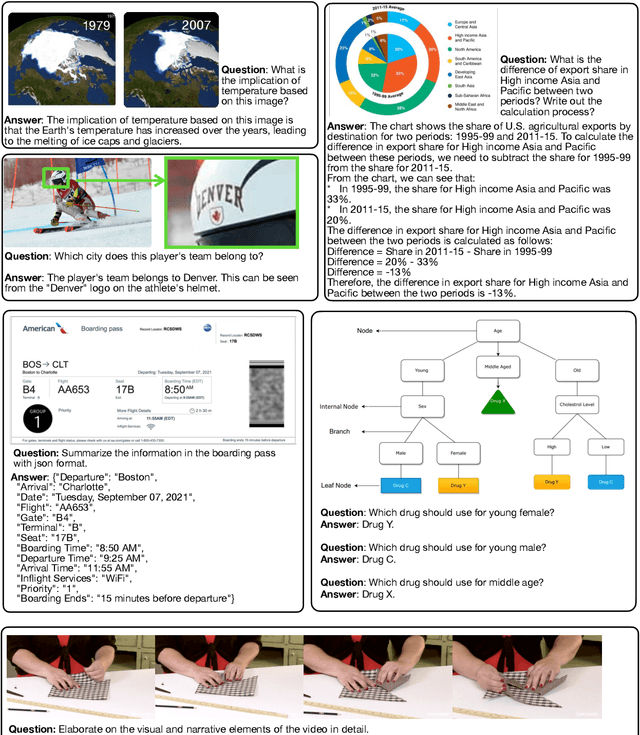

Abstract:Visual language models (VLMs) have made significant advances in accuracy in recent years. However, their efficiency has received much less attention. This paper introduces NVILA, a family of open VLMs designed to optimize both efficiency and accuracy. Building on top of VILA, we improve its model architecture by first scaling up the spatial and temporal resolutions, and then compressing visual tokens. This "scale-then-compress" approach enables NVILA to efficiently process high-resolution images and long videos. We also conduct a systematic investigation to enhance the efficiency of NVILA throughout its entire lifecycle, from training and fine-tuning to deployment. NVILA matches or surpasses the accuracy of many leading open and proprietary VLMs across a wide range of image and video benchmarks. At the same time, it reduces training costs by 4.5X, fine-tuning memory usage by 3.4X, pre-filling latency by 1.6-2.2X, and decoding latency by 1.2-2.8X. We will soon make our code and models available to facilitate reproducibility.
Eagle: Exploring The Design Space for Multimodal LLMs with Mixture of Encoders
Aug 28, 2024



Abstract:The ability to accurately interpret complex visual information is a crucial topic of multimodal large language models (MLLMs). Recent work indicates that enhanced visual perception significantly reduces hallucinations and improves performance on resolution-sensitive tasks, such as optical character recognition and document analysis. A number of recent MLLMs achieve this goal using a mixture of vision encoders. Despite their success, there is a lack of systematic comparisons and detailed ablation studies addressing critical aspects, such as expert selection and the integration of multiple vision experts. This study provides an extensive exploration of the design space for MLLMs using a mixture of vision encoders and resolutions. Our findings reveal several underlying principles common to various existing strategies, leading to a streamlined yet effective design approach. We discover that simply concatenating visual tokens from a set of complementary vision encoders is as effective as more complex mixing architectures or strategies. We additionally introduce Pre-Alignment to bridge the gap between vision-focused encoders and language tokens, enhancing model coherence. The resulting family of MLLMs, Eagle, surpasses other leading open-source models on major MLLM benchmarks. Models and code: https://github.com/NVlabs/Eagle
ARDuP: Active Region Video Diffusion for Universal Policies
Jun 19, 2024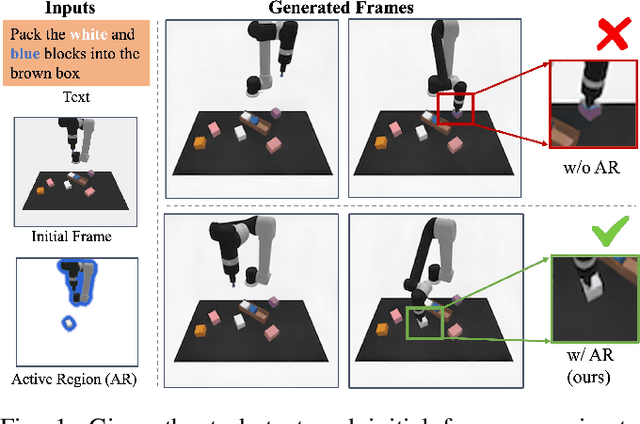
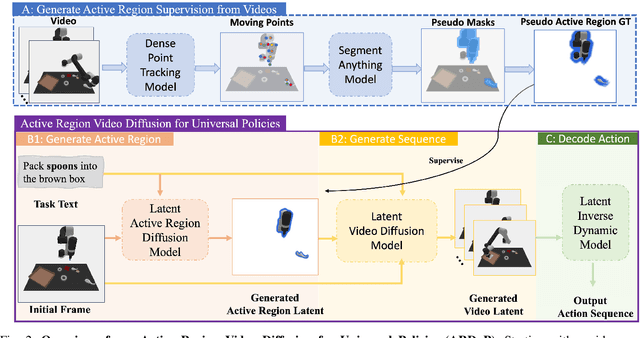
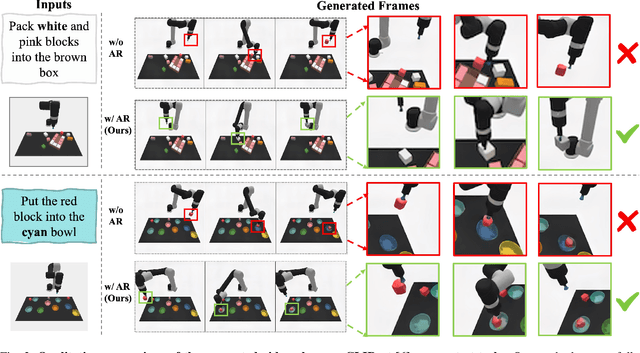
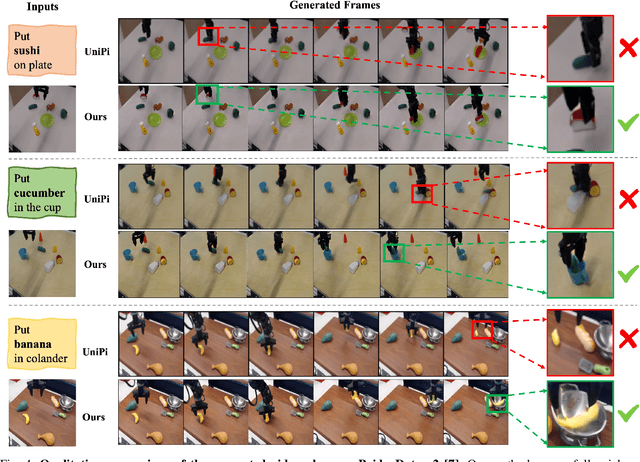
Abstract:Sequential decision-making can be formulated as a text-conditioned video generation problem, where a video planner, guided by a text-defined goal, generates future frames visualizing planned actions, from which control actions are subsequently derived. In this work, we introduce Active Region Video Diffusion for Universal Policies (ARDuP), a novel framework for video-based policy learning that emphasizes the generation of active regions, i.e. potential interaction areas, enhancing the conditional policy's focus on interactive areas critical for task execution. This innovative framework integrates active region conditioning with latent diffusion models for video planning and employs latent representations for direct action decoding during inverse dynamic modeling. By utilizing motion cues in videos for automatic active region discovery, our method eliminates the need for manual annotations of active regions. We validate ARDuP's efficacy via extensive experiments on simulator CLIPort and the real-world dataset BridgeData v2, achieving notable improvements in success rates and generating convincingly realistic video plans.
X-VILA: Cross-Modality Alignment for Large Language Model
May 29, 2024
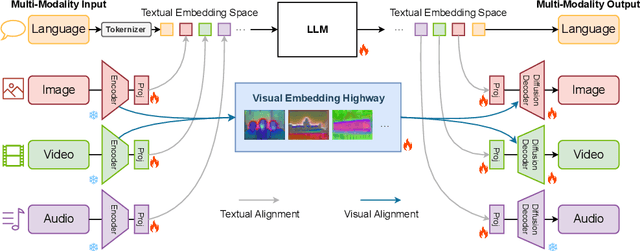

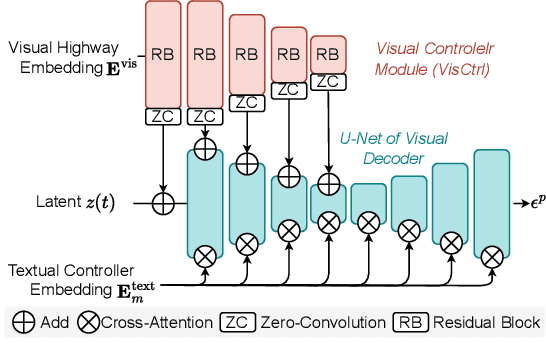
Abstract:We introduce X-VILA, an omni-modality model designed to extend the capabilities of large language models (LLMs) by incorporating image, video, and audio modalities. By aligning modality-specific encoders with LLM inputs and diffusion decoders with LLM outputs, X-VILA achieves cross-modality understanding, reasoning, and generation. To facilitate this cross-modality alignment, we curate an effective interleaved any-to-any modality instruction-following dataset. Furthermore, we identify a significant problem with the current cross-modality alignment method, which results in visual information loss. To address the issue, we propose a visual alignment mechanism with a visual embedding highway module. We then introduce a resource-efficient recipe for training X-VILA, that exhibits proficiency in any-to-any modality conversation, surpassing previous approaches by large margins. X-VILA also showcases emergent properties across modalities even in the absence of similar training data. The project will be made open-source.
What is Point Supervision Worth in Video Instance Segmentation?
Apr 01, 2024



Abstract:Video instance segmentation (VIS) is a challenging vision task that aims to detect, segment, and track objects in videos. Conventional VIS methods rely on densely-annotated object masks which are expensive. We reduce the human annotations to only one point for each object in a video frame during training, and obtain high-quality mask predictions close to fully supervised models. Our proposed training method consists of a class-agnostic proposal generation module to provide rich negative samples and a spatio-temporal point-based matcher to match the object queries with the provided point annotations. Comprehensive experiments on three VIS benchmarks demonstrate competitive performance of the proposed framework, nearly matching fully supervised methods.
LITA: Language Instructed Temporal-Localization Assistant
Mar 27, 2024Abstract:There has been tremendous progress in multimodal Large Language Models (LLMs). Recent works have extended these models to video input with promising instruction following capabilities. However, an important missing piece is temporal localization. These models cannot accurately answer the "When?" questions. We identify three key aspects that limit their temporal localization capabilities: (i) time representation, (ii) architecture, and (iii) data. We address these shortcomings by proposing Language Instructed Temporal-Localization Assistant (LITA) with the following features: (1) We introduce time tokens that encode timestamps relative to the video length to better represent time in videos. (2) We introduce SlowFast tokens in the architecture to capture temporal information at fine temporal resolution. (3) We emphasize temporal localization data for LITA. In addition to leveraging existing video datasets with timestamps, we propose a new task, Reasoning Temporal Localization (RTL), along with the dataset, ActivityNet-RTL, for learning and evaluating this task. Reasoning temporal localization requires both the reasoning and temporal localization of Video LLMs. LITA demonstrates strong performance on this challenging task, nearly doubling the temporal mean intersection-over-union (mIoU) of baselines. In addition, we show that our emphasis on temporal localization also substantially improves video-based text generation compared to existing Video LLMs, including a 36% relative improvement of Temporal Understanding. Code is available at: https://github.com/NVlabs/LITA
Efficient Video Diffusion Models via Content-Frame Motion-Latent Decomposition
Mar 21, 2024Abstract:Video diffusion models have recently made great progress in generation quality, but are still limited by the high memory and computational requirements. This is because current video diffusion models often attempt to process high-dimensional videos directly. To tackle this issue, we propose content-motion latent diffusion model (CMD), a novel efficient extension of pretrained image diffusion models for video generation. Specifically, we propose an autoencoder that succinctly encodes a video as a combination of a content frame (like an image) and a low-dimensional motion latent representation. The former represents the common content, and the latter represents the underlying motion in the video, respectively. We generate the content frame by fine-tuning a pretrained image diffusion model, and we generate the motion latent representation by training a new lightweight diffusion model. A key innovation here is the design of a compact latent space that can directly utilizes a pretrained image diffusion model, which has not been done in previous latent video diffusion models. This leads to considerably better quality generation and reduced computational costs. For instance, CMD can sample a video 7.7$\times$ faster than prior approaches by generating a video of 512$\times$1024 resolution and length 16 in 3.1 seconds. Moreover, CMD achieves an FVD score of 212.7 on WebVid-10M, 27.3% better than the previous state-of-the-art of 292.4.
 Add to Chrome
Add to Chrome Add to Firefox
Add to Firefox Add to Edge
Add to Edge